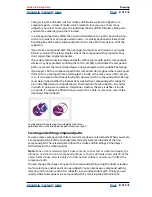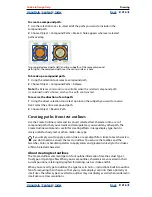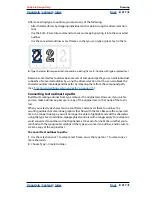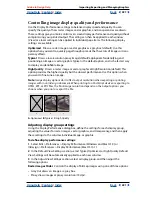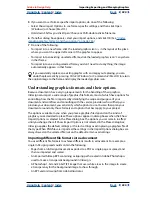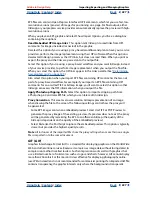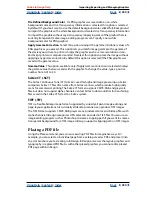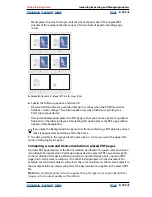
Using Help
|
Contents
|
Index
Back
229
Adobe InDesign Help
Importing, Exporting, and Managing Graphics
Using Help
|
Contents
|
Index
Back
229
The PCX format supports RGB, indexed-color, grayscale, and bitmap color modes, as well
as the RLE compression method, which is lossless. It does not support alpha channels.
Images can have a bit depth of 1, 4, 8, or 24 bits. However, PCX is not ideal for commer-
cially printed or online documents. PCX graphics can provide acceptable quality only
when printed on low-resolution or non PostScript printers.
PDF (.PDF)
The Adobe Acrobat Portable Document Format (PDF) is standard for the electronic distri-
bution and viewing of complete documents. It preserves the layout, typography, bitmap
images, and vector graphics files created in a great number of different applications. PDF
can preserve color quality and layout precision for prepress work while compressing
pages sufficiently for online distribution and viewing. PDF files can be viewed using the
free Acrobat Reader
®
. For all of these reasons, PDF is a common format on the World Wide
Web.
Based on the industry-standard Adobe PostScript 3
™
page-description language for
professional printing, PDF pages are similar to PostScript pages, but can also contain
multimedia elements and features for searching and navigating electronic documents. For
example, PDF files can contain movies, sound, hypertext links, and electronic tables of
contents. However, InDesign doesn’t import included movies, sound, links, or buttons
when you place a PDF file.
You can place a PDF page as a single graphic in InDesign using the Place command (see
“Placing a PDF file” on page 230
), or you can create an Acrobat 5.0–compatible PDF file
using the Export command (see
“Creating Adobe PDF Files” on page 361
).
If an imported PDF 1.4 (Acrobat 5.0) file contains transparent objects, the transparency is
preserved and will allow underlying artwork to show through.
PNG (.PNG)
The Portable Network Graphics (PNG) format uses adjustable, lossless compression to
display 24-bit photographs or solid-color images on the World Wide Web and in other
online media. PNG was developed as a patent-free alternative to the GIF file format. It
supports transparency in an alpha channel or a designated color. PNG is best used for
online documents, although its color support makes it better for printed documents than
GIF. However, color PNG graphics placed in an InDesign document are RGB bitmap
images, so they print only as composites, not on color separations.
When you place a PNG image, you can select Show Import Options to see a dialog box
with three panels of import settings. Two panels contain the same options available for
other bitmap image formats. The other panel, PNG Settings, contains the following
settings:
Use Transparency Information
This option is enabled by default when a PNG graphic
includes transparency. If an imported PNG file contains transparency, the graphic interacts
only where the background is transparent.
White Background
If a PNG graphic does not contain a file-defined background color,
this option will be selected by default. However, it is only enabled if Use Transparency
Information is activated. If this option is selected, white is used as the background color
when applying transparency information.

